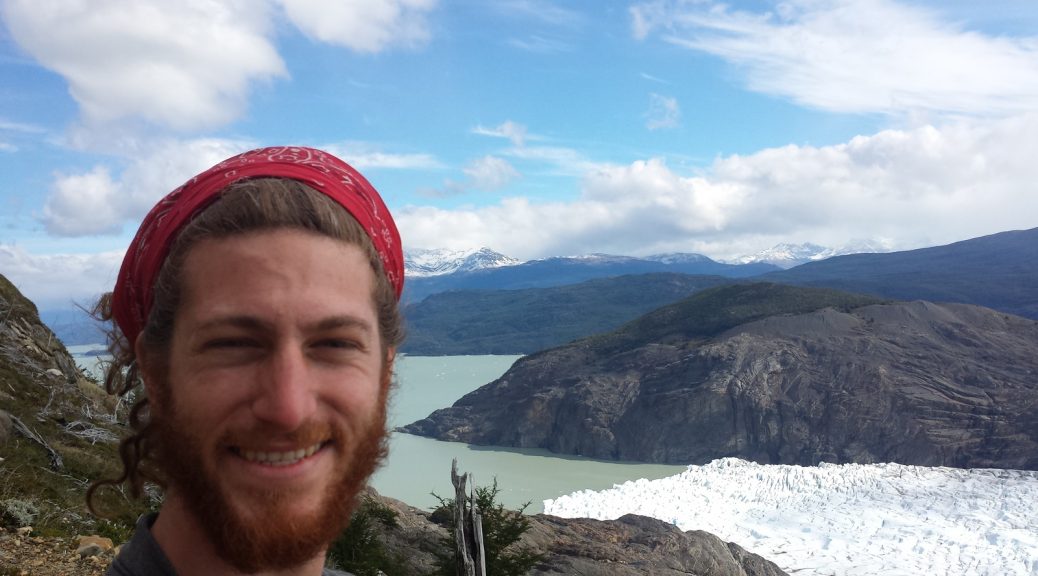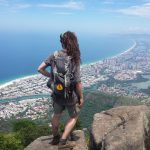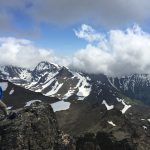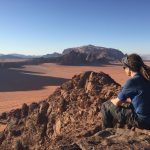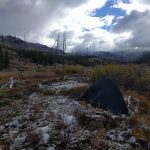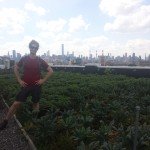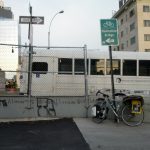After a week in Buenos Aires, my injuries sustained by 10 days of backpacking in Patagonia have mostly healed. I initially only intended the 123 km circut at Torres del Paine National Park in Southern Chile to take 7 days, but complications with rangers, a blizzard, and increasing pain in my ankles, feet, and–worst of all–my knees slowed my journey; fortunately I over-packed food.
my only ticket or reservation included this one-way plane ticket from Santiago de Chile to Punta Arenas–the furthest south I’ve ever been.
After 3 weeks in Santiago de Chile, with a brief weekend visit to Valpariso and Maintencillo to visit friends, I woke on Saturday–the first day of my 2 week vacation–at 05:30 to catch a plane to Punta Arenas. I had a rough sketch of plans from the time my plane arrived in this southern Chilean town until the time I was to arrive in Buenos Aires 2 weeks later, but my only ticket or reservation included this one-way plane ticket from Santiago de Chile to Punta Arenas–the furthest south I’ve ever been.

I arrived to the airport with a overly-stuffed backpack full of instant, no-heat, vegan, dehydrated trail food (couscous, instant potatoes, raisins, mixed nuts, tortillas, peanut butter, oil, and various soup & spice packets). My pack was bulging with two gigantic ever-running holes on the critical sides along the main zipper. My couchsurfing host amazingly had a half meter of webbing to give me just before graciously driving me to the airport, but I hadn’t time to sew my pack before the flight. I hastily pulled out my ~50ft of paracord, and tightly bound the pack with the entire length. I waited in line with all the other backpackers headed for Patagonia, sacrificed a lighter to the airport security, and boarded my plane.

After my arrival to the Punta Arenas airport, I searched for a bus to get to Puerta Natales–the gateway town a short 3 hour bus ride from the Torres Del Paine National Park. The information desk told me the inter-city busses picked up at the airport, but required tickets purchased in advance. I awaited one of these busses a few hours later, standing in a line with backpackers more prepared than I. When a bus arrived and my neighbors presented their pre-printed tickets, I asked the bus driver in my broken spanish if I could pay for the ride now. There was no issue; I was told to get on the bus. Moreover, I somehow blended-in with the group, as the ticket man walking up & down the isle demanding ticket proof never approached me.

After a sleepy ride on the bus with more comfortable chairs than the plane, we arrived to Puerto Natales’ main bus station. I previously searched for the cheapest hostel online, and walked there with my fingers crossed. They had a 13.000 CLP bed in a mixed dorm, and offered cheap luggage store during the trek for 1.000 CLP. I separated my items, leaving my electronics and some superfluous clothes & toiletries behind. I spent the rest of the night sewing long patches of webbing to pack’s critical rips. I ate dinner and went to bed early.
The next morning, I had a fast breakfast, grabbed my webbing-patched pack, and was on the bus to Torres Del Paine by 07:30. The scenery was mostly the same–Patagonia is mostly large, empty fields with cows–with only the occasional mountains & glaciers, to which I intended to immerse myself in shortly.
we had to ford a river…I stubbornly didn’t want to remove my boots, so I decided to jump…While I was able to jump to the sandbar without issue, I did so immediately after I had thrown my backpack directly into the water
We arrived, stood in line, paid for entry, and watched a bilingual video about the rules of the park. Their biggest concern was wild fires, as careless tourists from Czech Republic & Israel have tragically burned down nearly 500,000 hectares in 1985, 2005, and 2011. Personally, I didn’t even have a stove. Everything I had could be rehydrated cold–though I would never do this again where the water source is glacier melt and the temperature is regularly less than 10 degrees!

The first day’s trek from Laguna Amarga to the Seron campsite was probably the low-light of the trip. In fact, this whole 20km stretch was entirely private property. The first half of it was on a road, and the back half wasn’t especially beautiful either. Worse, it was drizzling when we arrived, but it picked-up & continued raining throughout the day. In fact, I never saw the sun my first 2 days in Torres Del Paine. At a certain point on the first day, we had to ford a river. I stubbornly didn’t want to remove my boots (my hands had long-since lost feeling, making tying shoelaces an extremely arduous task), so I decided to jump to a sandbar in the river; but I wasn’t confident I could clear it with my pack on, so I decided to throw my pack, then jump. While I was able to jump to the sandbar without issue, I did so immediately after I had thrown my backpack directly into the water, entirely submerging the bottom 2/3 of my pack, which included my heaviest food, tent, and–worst of all–my down sleeping bag! With great luck, I unpacked my sleeping bag later that night (which had been thoughtfully encased in a thin garbage bag, which was stuffed into a water-resistant compression sack) in my mostly-dry tent and found it to be 90% dry! Alas, for the rest of my journey, I ate damp nuts seasoned with a touch of Patagonia glacial melt.
I was refused passage when I told the rangers that I didn’t have reservations…In the morning, I…walked back the way I came…before ditching the trail, bypassing the ranger station, and meeting up with the trail a half-hour later en-route to Dickson
My poor 40L pack also suffered some damage on the first day. My sternum strap irreparably broke, and one of the clips on my (critical!) hipbelt snapped off. Fortunately I was still able to keep most of my load on my hips, though not as tight as I would have liked. The result was end-of-day shoulder pain, which was dwarfed by other pains that would soon ail me.

The 2nd day was more rainy. I decided to get a head-start on the 18km to Dickson, but I was refused passage when I told the rangers that I didn’t have reservations for either the Dickson or the Los Torres campgrounds. Besides temporarily destroying my hopes & dreams, they were extremely nice; they let me camp at their ranger station for the night and cook on their wood stove. I made the day-trip to Dickson to see the first glaciers, and returned to the ranger station at Coirón–making it a ~28km day for me.
In the morning, I slept-in, saw the sun for the first time, ate a warm meal, said goodbye to the rangers, and walked back the way I came from Seron for about 10 minutes–before ditching the trail, bypassing the ranger station, and meeting up with the trail a half-hour later en-route to Dickson. I did the same game in Dickson to avoid the rangers there, sleeping behind some logs near the first bridge after the mirador on the way to Los Perros. I walked about 14 km this day.
I was walking into the winds at a constant 45-degree angle…the gusts alone were enough to throw you down into rocks…a couple women were picked up off their feet by the wind & thrown into rocks. An old man was knocked into a rock & gashed his knee. I was fortunate.
By my 4th day I had a few nasty blisters and was already having pain my knees & ankles. I was rapidly approaching the John Gardner pass–which, with an alpine climb to 1,200 meters this far south, it’s by far the most difficult leg of the Torres Del Paine circuit. I decided to listen to my body. I decided to stop at Los Perros just before the ascent to the pass. It started snowing shortly before I arrived to the Los Perros campground, which was a magical experience as I approached the Los Perros Glacer on the way to the camground. I went through the trees to avoid the ranger station, setup my tent near others, and immediately went inside. It was the highest altitude campsite of my journey, so I layered up with every dry item of clothes I brought. Fortunately, it was not an especially cold night. I slept 12 hours.

The 5th day I woke up early, ate a light breakfast, and broke down my tent in the cold drizzle. My hands were so cold that I didn’t have the dextarity to clip my sutff sack onto my pack. Fortunately I found a small cooking shelter with a few dozen trekkers. The warm steamy structure was exactly what I needed to regain feeling in my fingertips, attach my stuffsack, prepare my mental state, and head up the mountain. If I had known what was to follow, I may have never left. I found out a few days later that–shortly after I stumbled my way over the top of the pass–the rangers closed access to the trail. In fact, there was a blizzard.
I had no idea how high we were going. When we first began trekking through snow & ice, it was a curious experience. I did not expect to continue ascending the ice in my worn-out, ill-equipped boots for hours. At its worst, the snow was knee-deep. If slipping-and-falling into rocks, snow, & ice due to poor traction were a concern in the beginning, I had no idea what was in store. After an hour ascending, the winds began to pickup. Near the top of the pass, I was walking into the winds at a constant 45-degree angle. When gusts came, there was no option–crouch as low as you could in the snow & wait. Every few minutes, the gusts alone were enough to throw you down into rocks. I found out later that at least a couple women were picked up off their feet by the wind & thrown into rocks. An old man was knocked into a rock & gashed his knee. I was more fortunate. I was most perilously blown into a large rock on one occasion–banging my knee. It was painful, but not an exceptional injury. At this point, enjoyment & pain were not palpable emotions. All that remained was adrenaline & survival. Keep moving. Get over the top. Get back to the tree line. And, for god’s sake, don’t sprain your ankle.
At this point, enjoyment & pain were not palpable emotions. All that remained was adrenaline & survival. Keep moving. Get over the top. Get back to the tree line.
Possibly the worst decision of ill-preparation in my undertaking of the circuit trek was not bringing trekking poles or gloves. The pain in my knees was obvious. I picked up a couple of wooden walking sticks from downed trees before undertaking the pass, and–while they were immensely useful at helping me walk on the ice–they progressively became shorter as I was knocked to the ground. At one point, I remember being thrown to the ground by the wind, picking myself up, and noticing a trail of blood in the snow from my glove-less handprint. I had long-since lost feeling in my hands, and I had no idea how much damage was being done. In my ignorance, I came to accept the possibility that I may have a few less fingers due to frost bite after this careless expedition. Fortunately, there was very little damage–other than a few cuts and several gnarly blisters from clutching my short, unergonomic walking sticks.

My weakened physical state also helped me in other unexpected ways. There were a few occasions on the pass where I stood aside to let a trailing group pass me. As the wind picked up near the top of the pass, the sleet came with it. At these winds, the sleet was painful on the face, and it made looking up to find the trail impossible. Fortunately, there was a group of about 5 that passed me before the wind & sleet made forward eyesight impossible, so I was able to merely follow their footprints. I heard horror stores of those who left the campsite later than I, who had to retrace their steps after getting lost on the pass since fresh snow had covered footprints and the wind/sleet made finding the trail extremely difficult.
Eventually, after hours of ever-climbing & falling in ice, then blindly following the footsteps of my unknown leaders, I cleared the pass and began to descend. After some time, the wind was broken enough to where I could gaze up, and the sight rewarded me with the most beautiful vista of my entire journey: the enormous stretch of Glacier Grey, filling a wide valley. It was met by a few other glaciers between the mountain peaks. The glacier appeared to continue to eternity. I stopped briefly to admire it (I was incapable of taking any pictures), before continuing my trek down to the muddy treeline.
I remember being thrown to the ground by the wind, picking myself up, and noticing a trail of blood in the snow from my glove-less handprint. I had long-since lost feeling in my hands…
After a few hours of slowly & painfully descending the steep slopes, occasionally slipping on the mud, I arrived to the Paso campground shortly after 15:00. The wind was calm & the sunlight was peaking out behind the intermittent clouds. I removed my jacket, boots, & socks, and bathed in the glorious sunlight in full appreciation for my life & fingers. Unfortunately, I found myself sun bathing immediately in front of the ranger’s station, and I was approached, asking to produce proof of my campground reservation–which I couldn’t. He told me I must keep going to the next campground, Glacier Grey, which was an additional 5 hour trek down the mountain. After 30 minutes of intermittent sun bathing & swapping survival stories of my comrades (all of whom agreed that it was the scariest day of their lives & whom were astonished that the rangers let us go in those conditions at all), I put on my boots and headed down the trail.
When I finally arrived to the Glacier Grey campground, I immediately setup my tent, took my first (hot) shower of the trip, washed my clothes, and went to sleep. After laying in dry clothes and crawling into my sleeping bag, I laughed & cried to myself as I lay clean, warm, and dry in my tent–alive. It was a 15 km day, and it was the scariest day of my life.
When I finally arrived...crawling into my sleeping bag, I laughed & cried to myself as I lay clean, warm, and dry in my tent--alive...it was the scariest day of my life.
I awoke the next morning, limped my way to the cooking shelter, and prepared an enormous breakfast. This was my first day on the “W” trek–which is much more populated, and full of “trekkers” sleeping in beds, only carrying daypacks. I swapped horror stories of the pass with my comrads who came into the campground for lunch, and started out late for Paine Grande, 11 km away.
On my 7th day, I took an exceptionally short day to the Italiano campground, 7.5 km away.
The next day I left my tent at camp, climbed the middle of the W–up through the Valle del Frances to the Mirador Britanico. I was rewarded by a marvelous, nearly 360-degree view of snow & glacier-capped mountains The very tip of the torres was just barely visible to the East. I returned to camp Italiano, grabbed the rest of my gear, and headed to the campsite. This was a 13 km day, and a very steep one.
I…slowly limped my way out of the mountains towards the bus that would take me back to Puerto Natales…to a hot shower, laundry, and the biggest bowl of guacamole I’ve ever eaten
By my 9th day, I was feeling much better. I could climb much easier than I could descend due to my knees, so I was able to cover the 22 km to the Torres CONAF campground without too much difficulty.
I woke on my 10th day at 03:30, climbed by the twilight up the rocky path to the Mirador at the base of the Torres, watched the light from the sunrise slide down the towers, and slowly limped my way out of the mountains towards the bus that would take me back to Puerto Natales from Laguna Amarga–18 km and a sleepy bus ride to a hot shower, laundry, and the biggest bowl of guacamole I’ve ever eaten 🙂
